Quantitative Correlation and Control Strategy for Element Content Fluctuation along Casting Direction in Central Area of Continuous Casting Billet
Abstract
1. Introduction
2. Experimental Procedures
2.1. Research Object and Analysis Areas
2.2. Characterization of Segregation Degree
2.3. Determination of CET Position
2.4. Statistical Correlation
3. Results and Discussion
3.1. Quantitative Correlation between Solidification Structure and Central Segregation
3.1.1. Fluctuation Correlation
3.1.2. Hysteretic Correlation
3.2. Effect of Casting Speed on the Solidification Structure Fluctuation
3.3. Formation Mechanism and Control Strategy of Central Segregation
4. Conclusions
- (1)
- During the CC process, the casting speed will influence the uniformity of the CET position by affecting the fluid flow in the billet. Under lower casting speed, the velocity gradient of molten steel along the casting direction is larger, and the flow is unstable. In this case, the distribution of the dendrites transported by the fluid flow will be also unstable, leading to the more serious fluctuation of the CET position. Under higher casting speed, the velocity gradient is smaller, thus the dendrite distribution driven by the liquid flow is more uniform, leading to a more stable distribution of CET position.
- (2)
- The formation mechanism of central segregation along the casting direction obtained from this research includes two aspects. First, during the CC process, solute elements are enriched at the solid–liquid interface and distributed in the equiaxed zone after CET. At this time, the fluctuation of the equiaxed crystal zone width will affect the distribution of the enriched solute in the billet and cause the fluctuation of the central segregation. Second, at the end of solidification, there is a pumping effect from the endpoint of solidification to the hysteretic solute-enriched liquid phase and finally forms the central V-shaped segregation in the central area.
- (3)
- During the CC process, the equiaxed crystal zone width or columnar crystal length should be kept stable to improve the quality uniformity. At the same time, the central segregation is mainly affected by the equiaxed crystal zone width at the hysteretic position. Thus, control measures applied before the equiaxed crystal zone is completely formed will be meaningful. Combined with the more stable solidification structure, the V-shaped segregation defect on the vertical section of the billet can be reduced.
Author Contributions
Funding
Data Availability Statement
Acknowledgments
Conflicts of Interest
References
- Lage, M.G.; Silva, A.L.V.D.C.E. Evaluating segregation in HSLA steels using computational thermodynamics. J. Mater. Res. Technol. 2015, 4, 353–358. [Google Scholar] [CrossRef]
- Long, M.; Chen, D. Study on Mitigating Center Macro-Segregation During Steel Continuous Casting Process. Steel Res. Int. 2011, 82, 847–856. [Google Scholar] [CrossRef]
- Su, L.; Li, H.; Lu, C.; Li, J.; Fletcher, L.; Simpson, I.; Barbaro, F.; Zheng, L.; Bai, M.; Shen, J.; et al. Transverse and z-Direction CVN Impact Tests of X65 Line Pipe Steels of Two Centerline Segregation Ratings. Met. Mater. Trans. A 2016, 47, 3919–3932. [Google Scholar] [CrossRef]
- Guo, F.; Wang, X.; Liu, W.; Shang, C.; Misra, R.D.K.; Wang, H.; Zhao, T.; Peng, C. The Influence of Centerline Segregation on the Mechanical Performance and Microstructure of X70 Pipeline Steel. Steel Res. Int. 2018, 89, 1800407. [Google Scholar] [CrossRef]
- Wang, W.; Hou, Z.-B.; Chang, Y.; Cao, J.-H. Effect of superheat on quality of central equiaxed grain zone of continuously cast bearing steel billet based on two-dimensional segregation ratio. J. Iron Steel Res. Int. 2018, 25, 9–18. [Google Scholar] [CrossRef]
- Li, J.; Wang, B.; Ma, Y.; Cui, J. Effect of complex electromagnetic stirring on inner quality of high carbon steel bloom. Mater. Sci. Eng. A 2006, 425, 201–204. [Google Scholar] [CrossRef]
- Guan, R.; Ji, C.; Zhu, M. Modeling the Effect of Combined Electromagnetic Stirring Modes on Macrosegregation in Continuous Casting Blooms. Met. Mater. Trans. A 2020, 51, 1137–1153. [Google Scholar] [CrossRef]
- Ogibayashi, S.; Kobayashi, M.; Yamada, M.; Mukai, T. Influence of Soft Reduction with One-piece Rolls on Center Segregation in Continuously Cast Slabs. ISIJ Int. 1991, 31, 1400–1407. [Google Scholar] [CrossRef]
- Yim, C.H.; Kil Park, J.; You, B.D.; Yang, S.M. The Effect of Soft Reduction on Center Segregation in C.C. Slab. ISIJ Int. 1996, 36, S231–S234. [Google Scholar] [CrossRef]
- Raihle, C.-M.; Fredriksson, H. On the formation of pipes and centerline segregates in continuously cast billets. Met. Mater. Trans. A 1994, 25, 123–133. [Google Scholar] [CrossRef]
- Hou, Z.; Wen, G.; Tang, P.; Cheng, G. Periodicity of Carbon Element Distribution along Casting Direction in Continuous-Casting Billet by Using Singular Spectrum Analysis. Met. Mater. Trans. A 2014, 45, 1817–1826. [Google Scholar] [CrossRef]
- Guo, D.-W.; Hou, Z.-B.; Cao, J.-H.; Guo, Z.-A.; Chang, Y.; Wen, G.-H. Prediction of maximum carbon element content in continuous casting billets of 82B cord steel based on statistics of extreme values method. J. Iron Steel Res. Int. 2020, 27, 1–7. [Google Scholar] [CrossRef]
- Choudhary, S.; Ganguly, S.; Sengupta, A.; Sharma, V. Solidification morphology and segregation in continuously cast steel slab. J. Mater. Process. Technol. 2017, 243, 312–321. [Google Scholar] [CrossRef]
- Flemings, M.C. Our Understanding of Macrosegregation. Past and Present. ISIJ Int. 2000, 40, 833–841. [Google Scholar] [CrossRef]
- Xu, Z.; Wang, X.; Huang, F.; Zhou, L.; Wang, W.; Yin, Y. Semi-macro segregation and solidification structure of pipeline steel continuous casting slabs. J. Univ. Sci. Technol. Beijing 2014, 36, 751–756. [Google Scholar] [CrossRef]
- Hunt, J. Steady state columnar and equiaxed growth of dendrites and eutectic. Mater. Sci. Eng. 1984, 65, 75–83. [Google Scholar] [CrossRef]
- Shibata, H.; Itoyama, S.; Kishimoto, Y.; Takeuchi, S.; Sekiguchi, H. Prediction of Equiaxed Crystal Ratio in Continuously Cast Steel Slab by Simplified Columnar-to-Equiaxed Transition Model. ISIJ Int. 2006, 46, 921–930. [Google Scholar] [CrossRef][Green Version]
- Niu, L.; Qiu, S.-T.; Zhao, J.-X.; Chen, Y.-Q.; Yang, S.-F. Processing parameter optimization for continuous casting of 38CrMoAl round bloom based on a prediction model of the equiaxed crystal ratio. Ironmak. Steelmak. 2018, 46, 835–844. [Google Scholar] [CrossRef]
- Ji, Y.; Tang, H.; Lan, P.; Shang, C.; Zhang, J. Effect of Dendritic Morphology and Central Segregation of Billet Castings on the Microstructure and Mechanical Property of Hot-Rolled Wire Rods. Steel Res. Int. 2017, 88, 1600426. [Google Scholar] [CrossRef]
- Li, B.; Zhang, Z.; Liu, H.; Luo, M.; Lan, P.; Tang, H.; Zhang, J. Characteristics and evolution of the spot segregations and banded defects in high strength corrosion resistant ”tube steel”. Acta. Metall. Sin. 2019, 55, 762–772. [Google Scholar] [CrossRef]
- Li, J.-M.; Jiang, M.-F.; Ning, J.-X.; Zhai, J. Effect of casting speed on dendrite arm spacing of Mn13 steel continuous casting slab. J. Iron Steel Res. Int. 2020, 27, 665–672. [Google Scholar] [CrossRef]
- El-Bealy, M.; Thomas, B.G. Prediction of dendrite arm spacing for low alloy steel casting processes. Met. Mater. Trans. A 1996, 27, 689–693. [Google Scholar] [CrossRef]
- Hodgson, P.; Kong, L.; Davies, C. The prediction of the hot strength in steels with an integrated phenomenological and artificial neural network model. J. Mater. Process. Technol. 1999, 87, 131–138. [Google Scholar] [CrossRef]
- Ji, Y.; Lan, P.; Geng, H.; He, Q.; Shang, C.; Zhang, J. Behavior of Spot Segregation in Continuously Cast Blooms and the Resulting Segregated Band in Oil Pipe Steels. Steel Res. Int. 2018, 89, 1700331. [Google Scholar] [CrossRef]
- Siqueira, C.; Cheung, N.; Garcia, A. The columnar to equiaxed transition during solidification of Sn–Pb alloys. J. Alloy. Compd. 2003, 351, 126–134. [Google Scholar] [CrossRef]
- Liu, H.; Xuan, W.; Xie, X.; Li, C.; Wang, J.; Yu, J.; Li, X.; Zhong, Y.; Ren, Z. Columnar-to-Equiaxed Transition and Equiaxed Grain Alignment in Directionally Solidified Ni3Al Alloy Under an Axial Magnetic Field. Met. Mater. Trans. A 2017, 48, 4193–4203. [Google Scholar] [CrossRef]
- Harada, H.; Miyazawa, K.; Matsumiya, T. Numerical modeling of columnar to equiaxed transition with consideration of molten steel flow. Int. J. Cast Met. Res. 2003, 15, 301–305. [Google Scholar] [CrossRef]
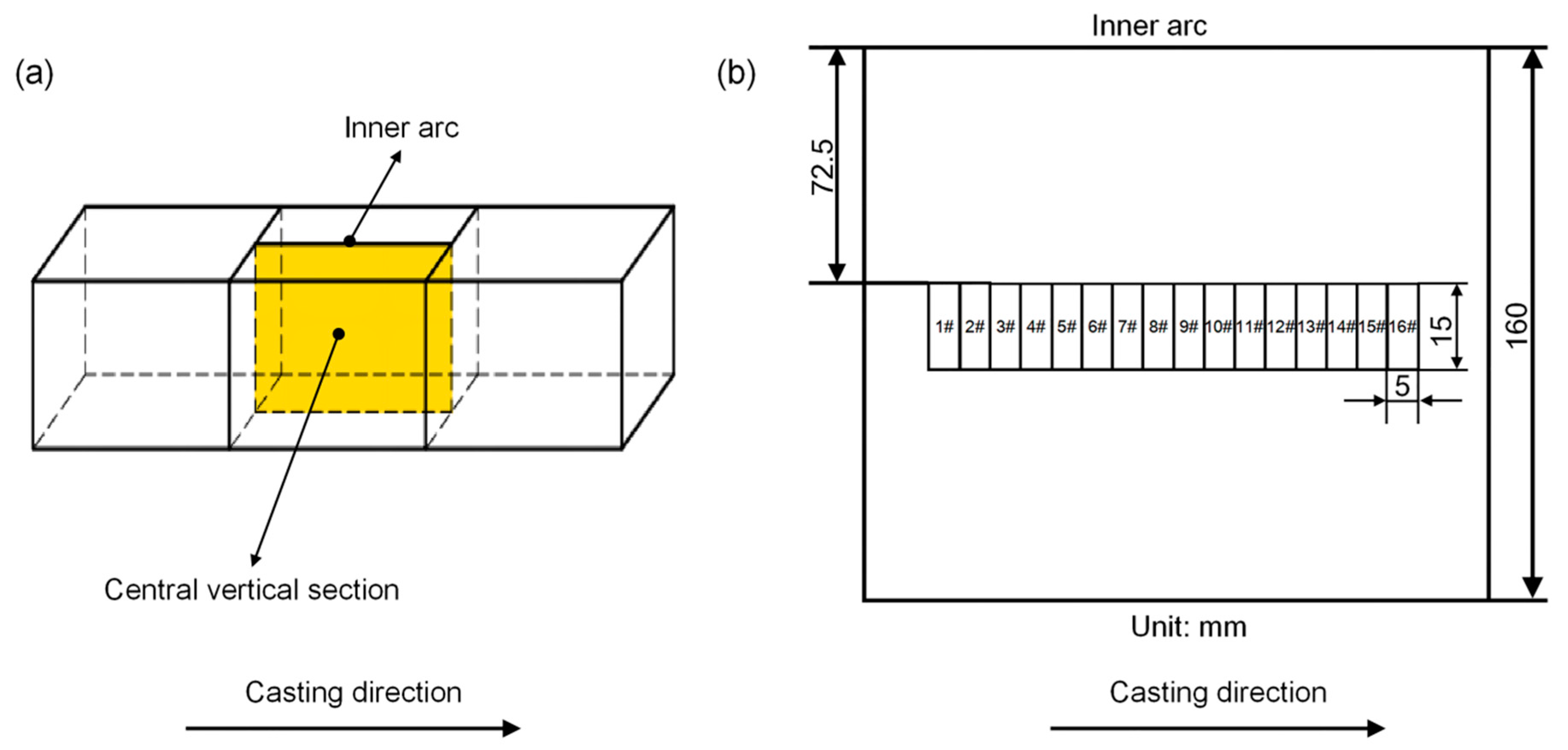
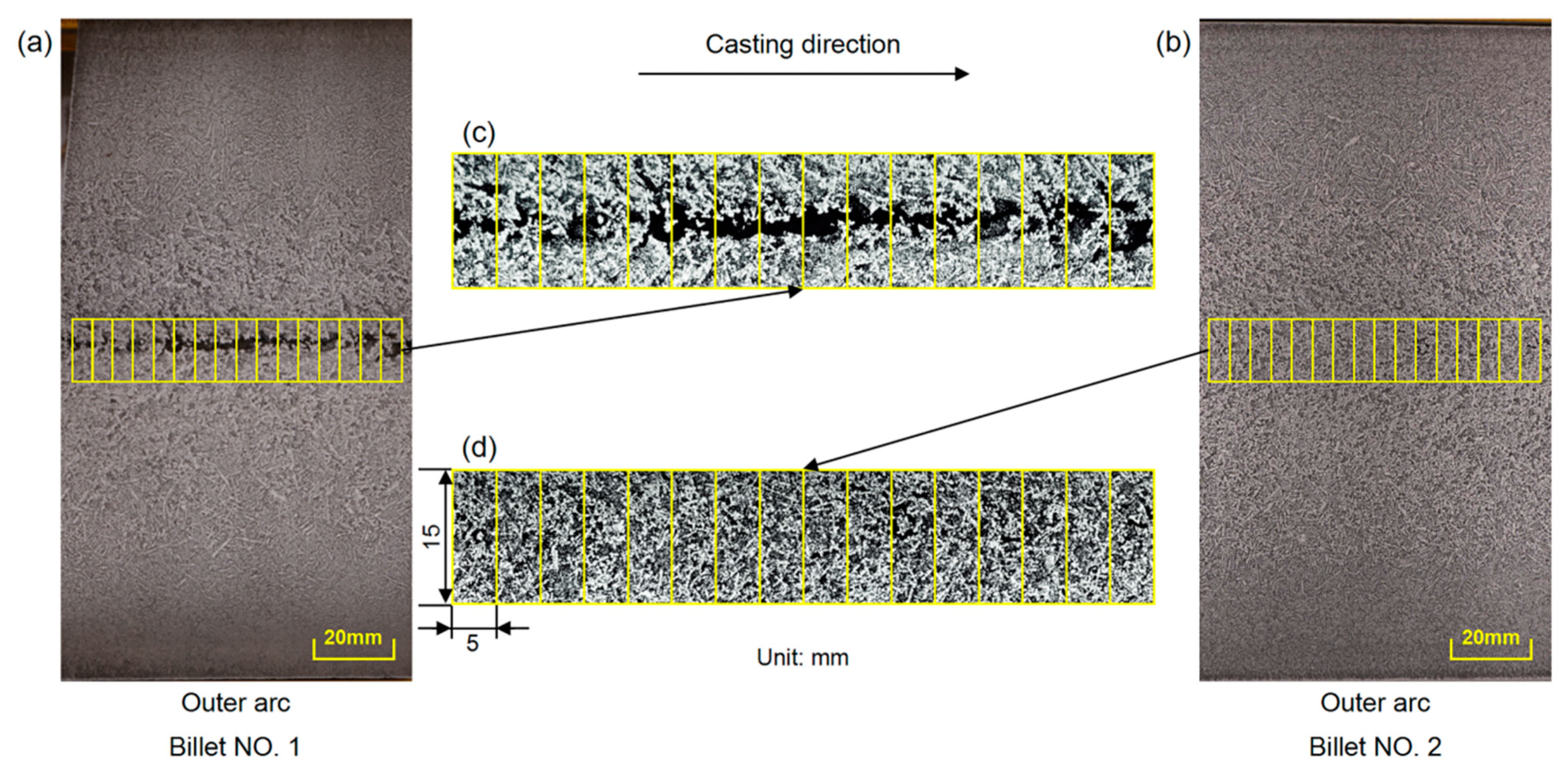
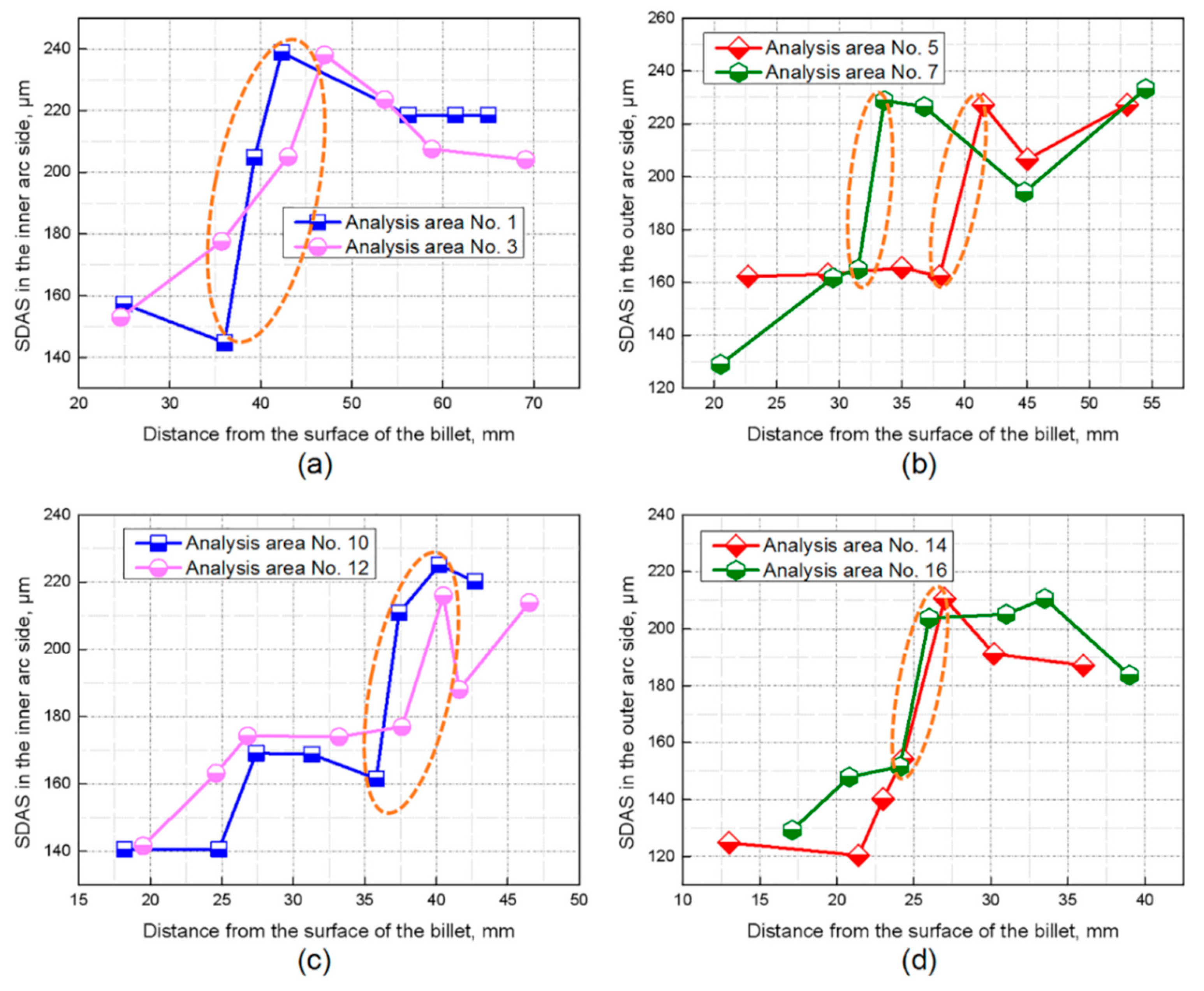
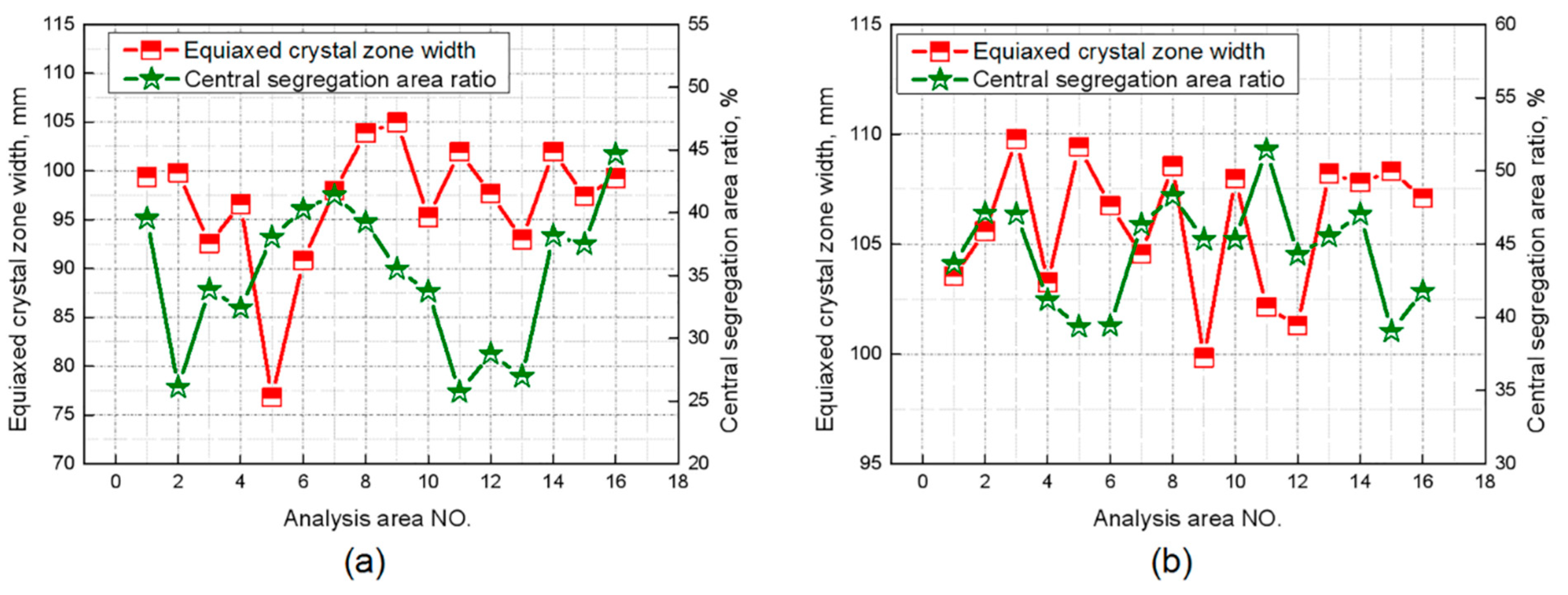
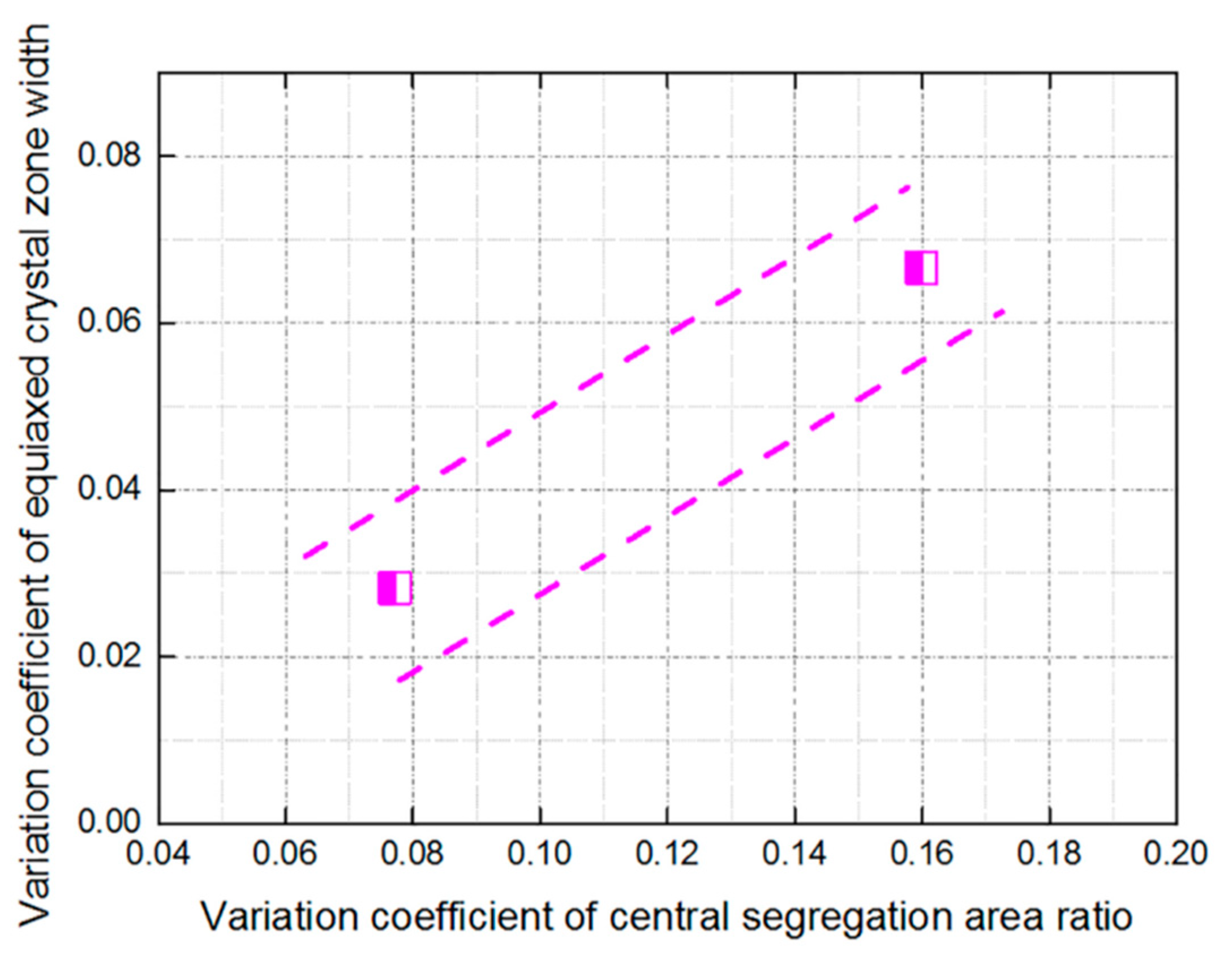
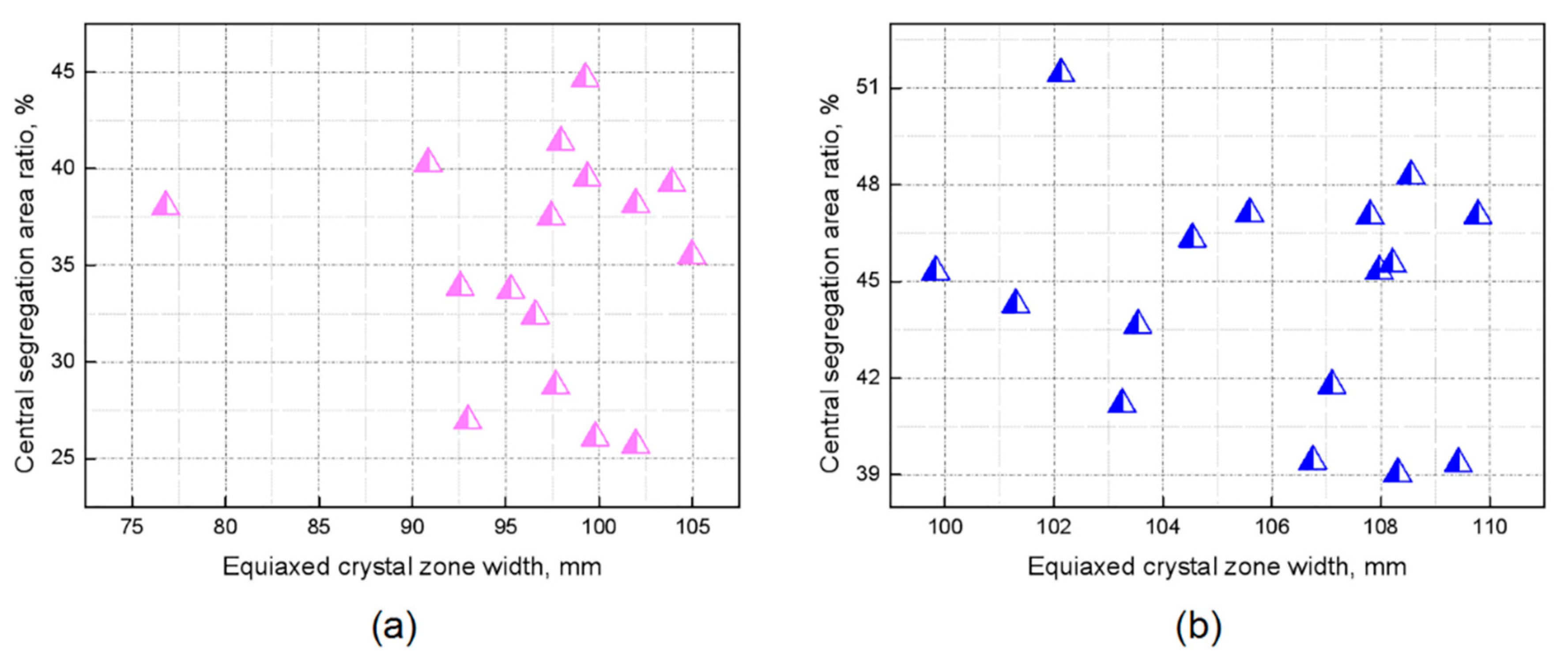
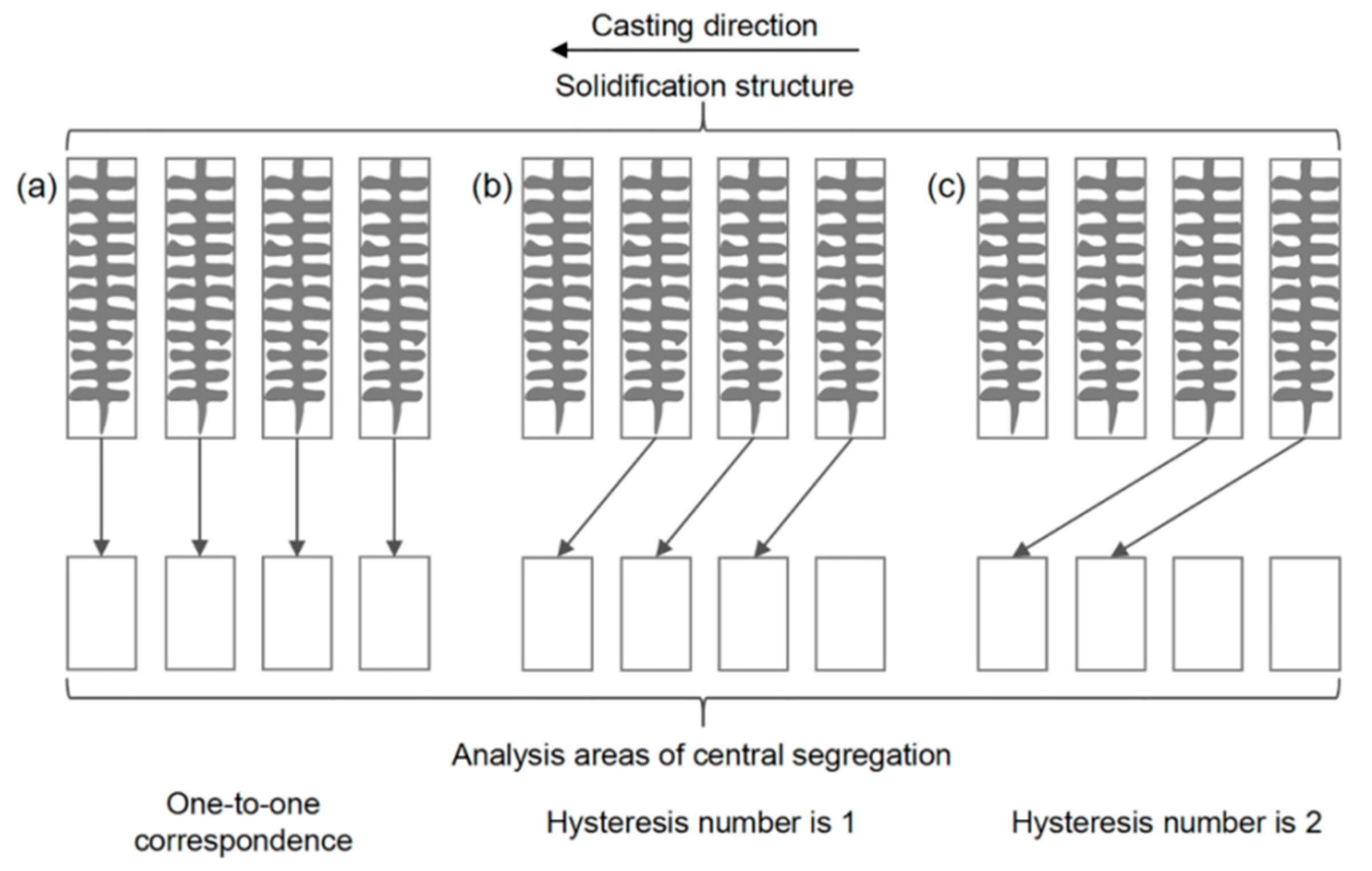
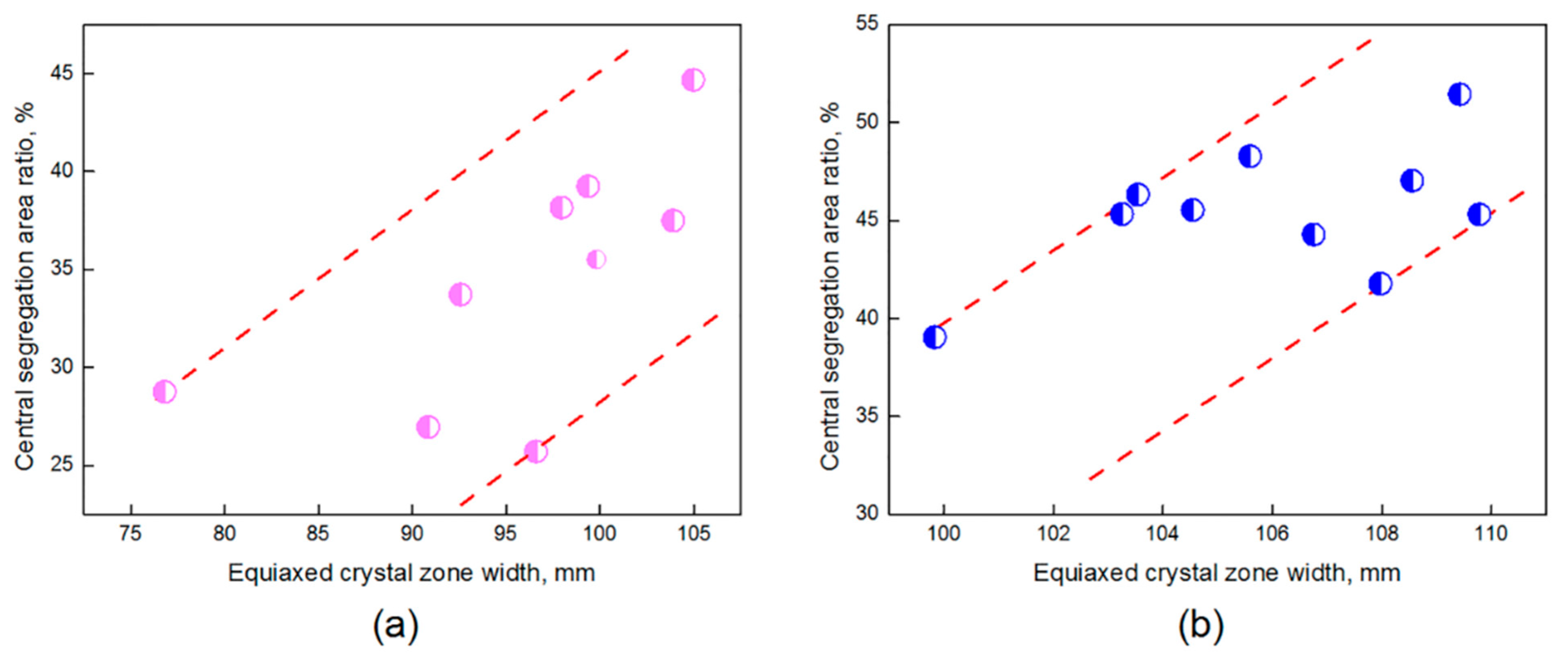

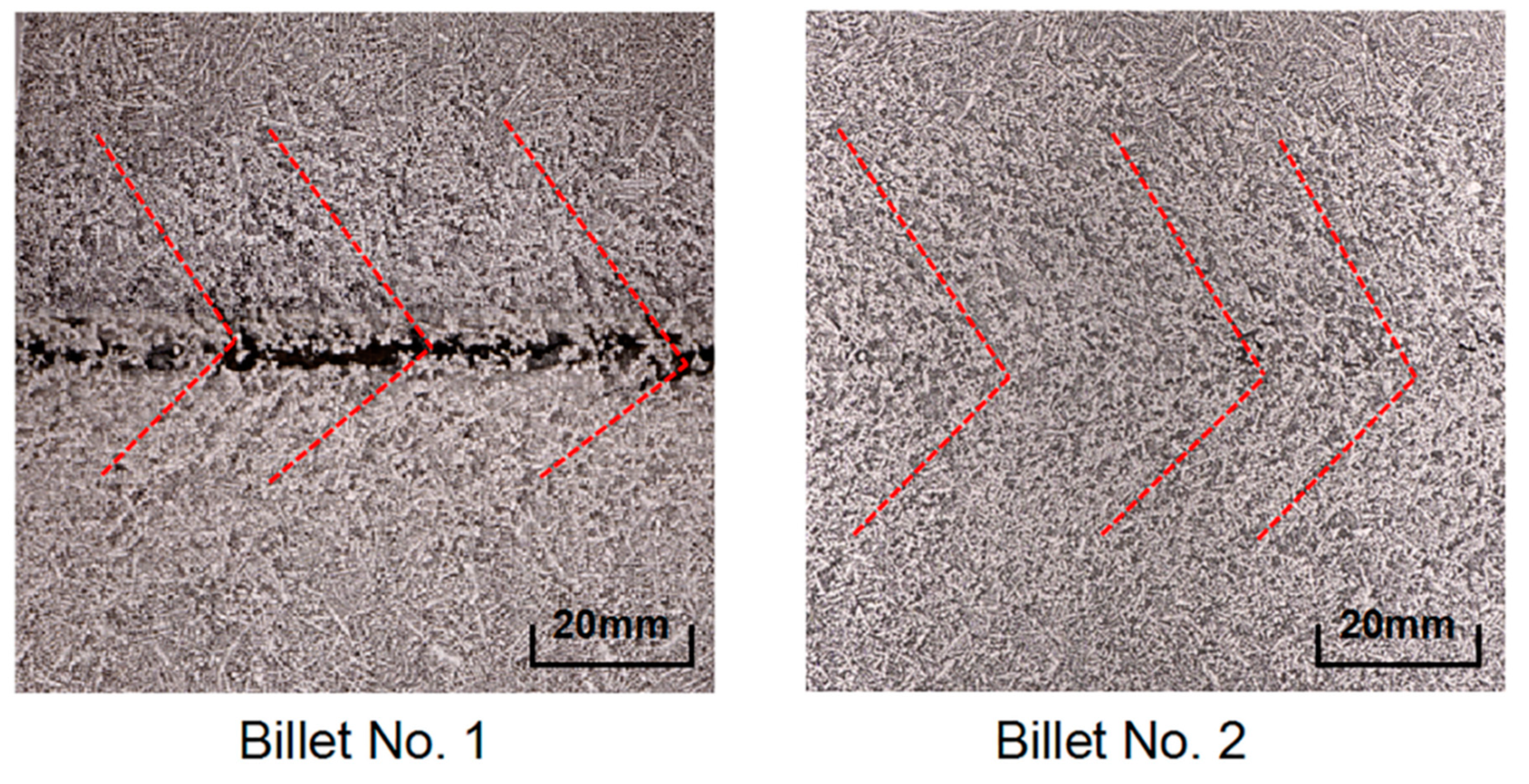
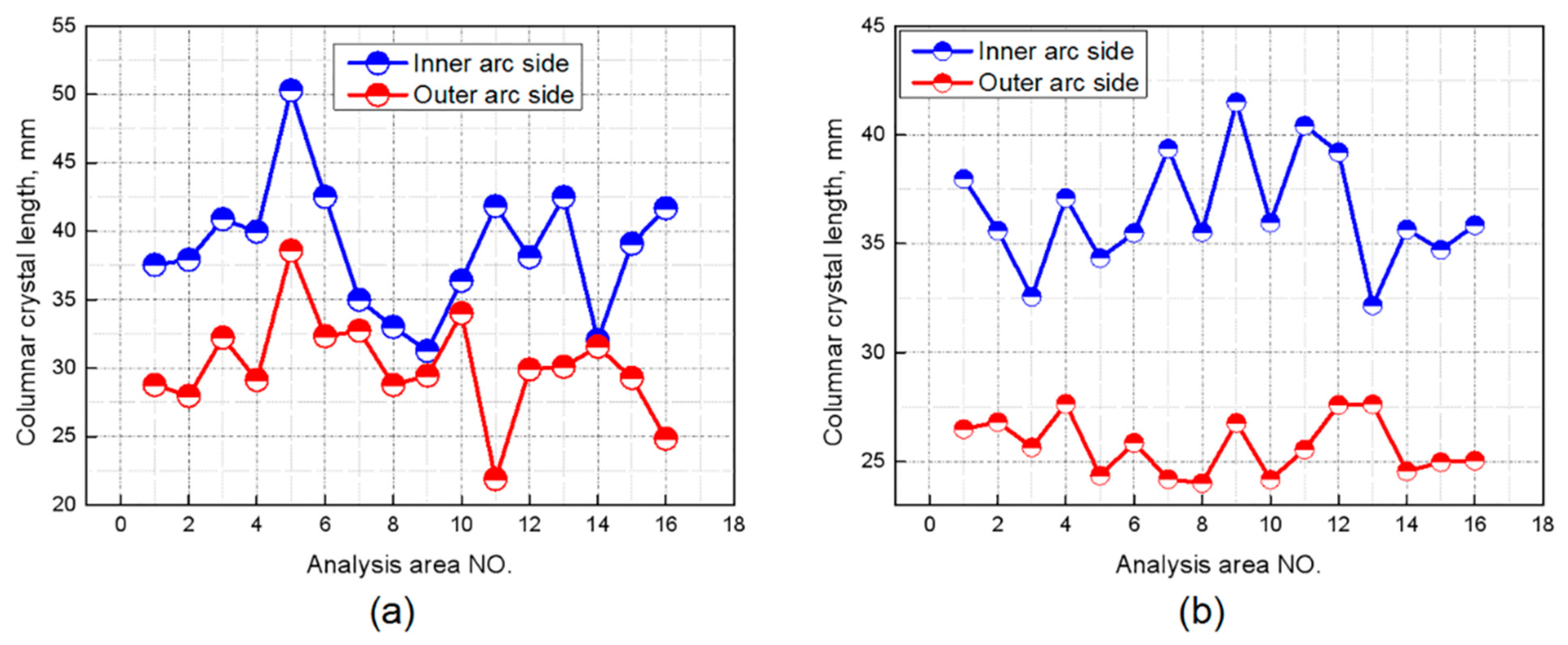
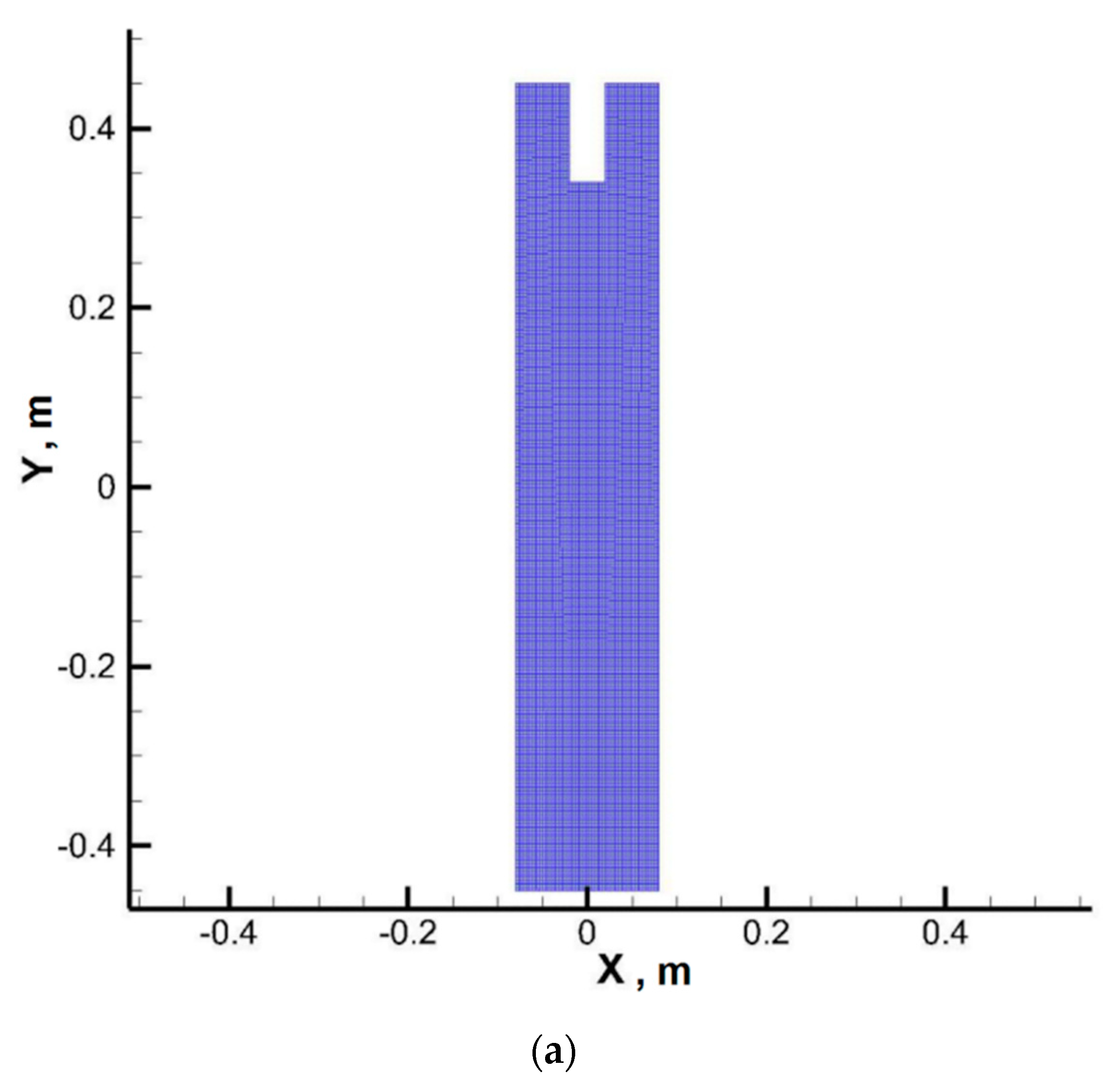
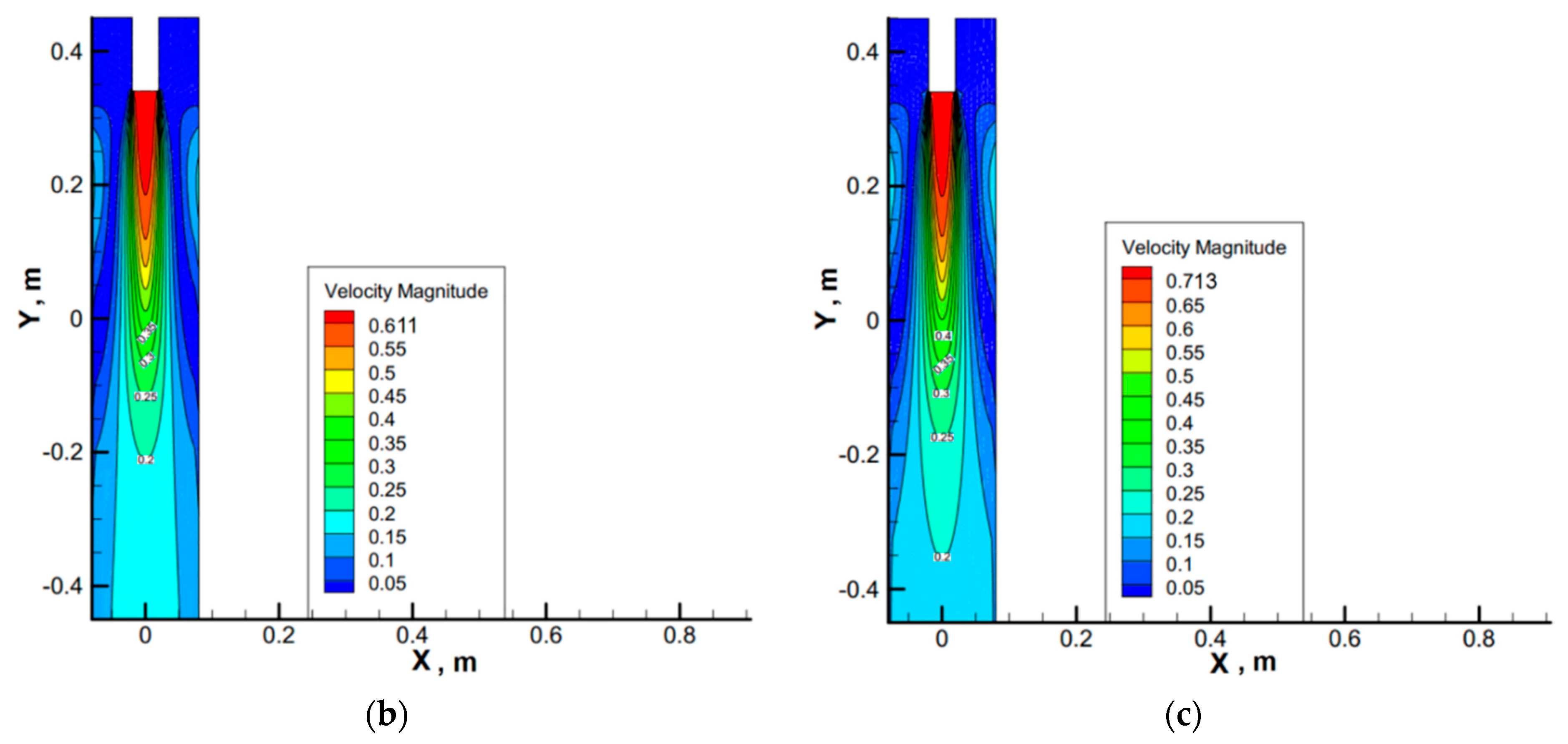
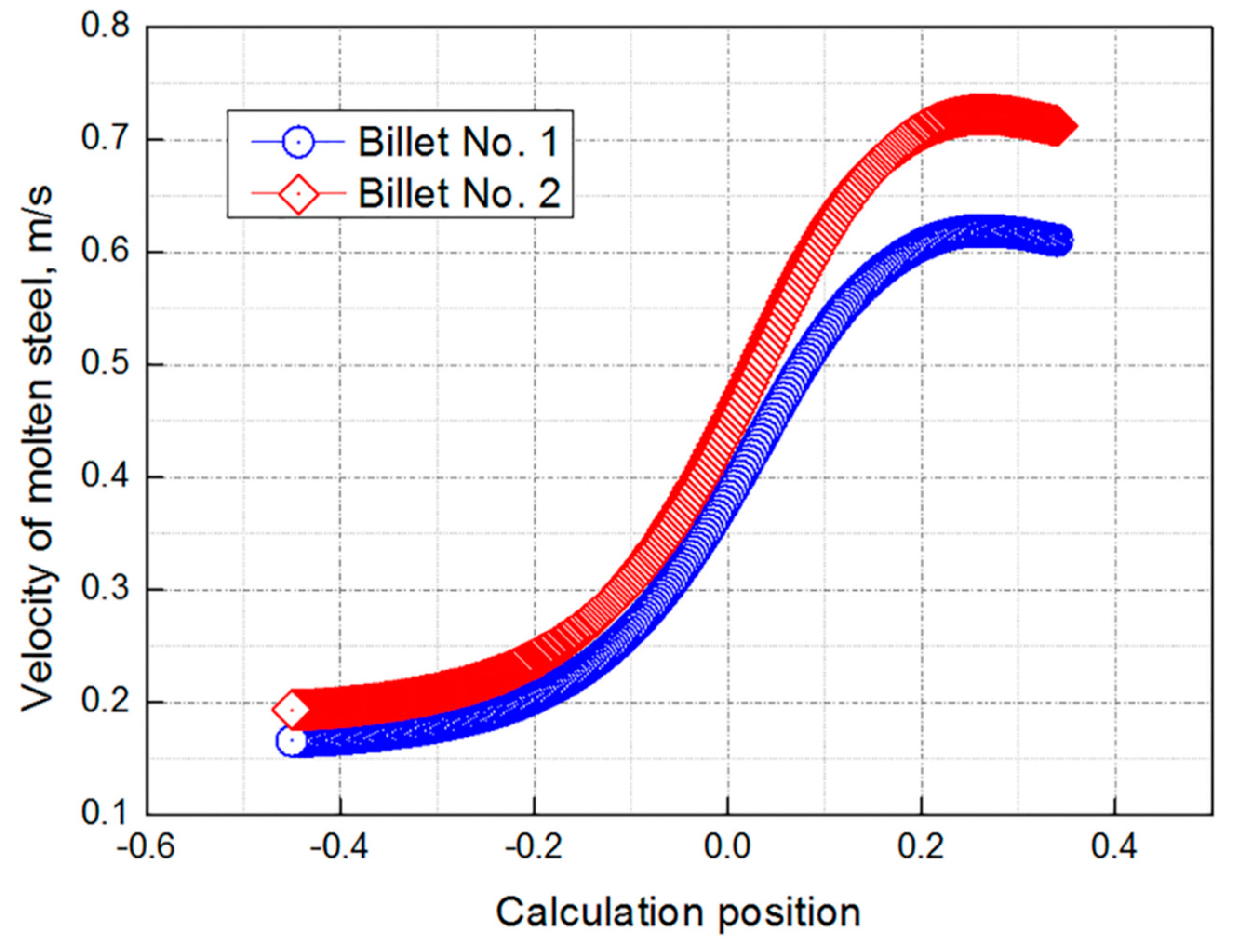
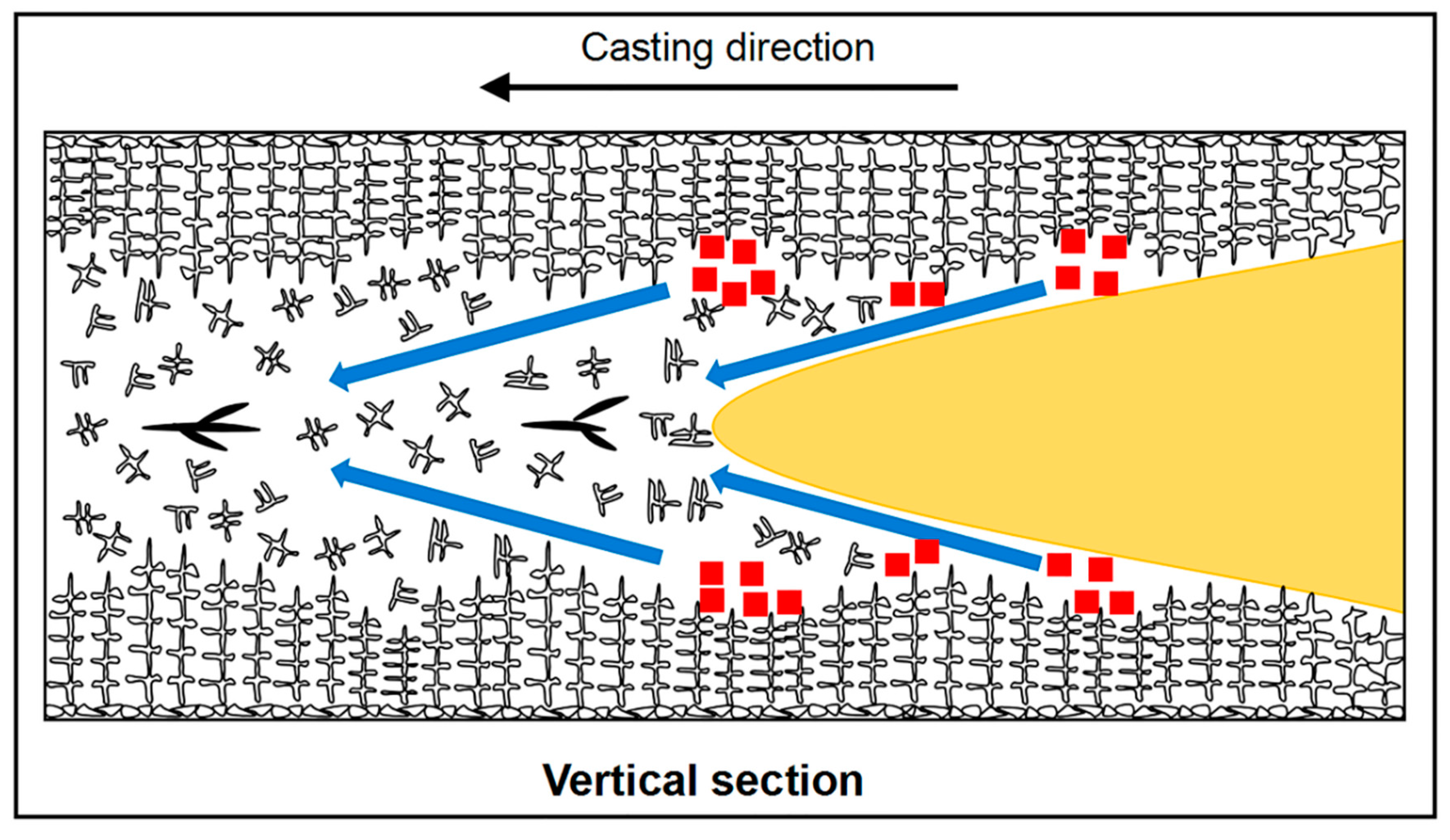
| Sample | Superheat, °C | Casting Speed, m/min | Specific Water Amount, L/kg |
|---|---|---|---|
| No. 1 | 42 | 1.8 | 0.68 |
| No. 2 | 40 | 2.1 | 0.68 |
| Billet No. 1 | Billet No. 2 | ||||
|---|---|---|---|---|---|
| Hyteresis Numbers | Pearson Correlation Coefficient | Significance Level α | Hyteresis Numbers | Pearson Correlation Coefficient | Significace Level α |
| 0 | −0.068 | 0.803 | 0 | −0.199 | 0.460 |
| 1 | −0.319 | 0.247 | 1 | −0.190 | 0.497 |
| 2 | −0.485 | 0.079 | 2 | −0.495 | 0.072 |
| 3 | −0.458 | 0.116 | 3 | 0.181 | 0.555 |
| 4 | −0.220 | 0.492 | 4 | 0.254 | 0.425 |
| 5 | 0.219 | 0.518 | 5 | 0.175 | 0.607 |
| 6 | 0.592 | 0.071 | 6 | 0.540 | 0.107 |
| 7 | 0.673 | 0.047 | 7 | −0.257 | 0.505 |
| 8 | 0.619 | 0.102 | 8 | 0.443 | 0.271 |
| Sample | Average Central Segregation Area Ratio, % | Average Equiaxed Crystal Zone Width, mm |
|---|---|---|
| No. 1 | 35.11 | 96.83 |
| No. 2 | 44.50 | 105.88 |
| Billet No. 1 | Billet No. 2 | ||
|---|---|---|---|
| Average hysteretic angle, ° | 89.67 | Average hysteretic angle, ° | 103.90 |
| Average V-shaped segregation angle, ° | 94.33 | Average V-shaped segregation angle, ° | 102.67 |
| Relative error, % | 4.95 | Relative error, % | 1.20 |
| Characteristics Parameters | Billet No. 1 | Billet No. 2 | |
|---|---|---|---|
| Casting speed, m/min | 1.8 | 2.1 | |
| Variation coefficient of central segregation area ratio | 0.1599 | 0.0772 | |
| Variation coefficient of columnar crystal length | Inner arc side | 0.1192 | 0.0701 |
| Outer arc side | 0.1206 | 0.0493 | |
| Average columnar crystal length/mm | Inner arc side | 38.75 | 36.46 |
| Outer arc side | 30.10 | 25.71 | |
| Parameters | Values |
|---|---|
| Model Length, m | 0.9 |
| Model Width, m | 0.16 |
| Submerged Depth, m | 0.11 |
| Density, kg/m3 | 7020 |
| Viscosity, Pa × s | 0.0067 |
| Samples | Velocity Discrepancy, m/s | Distance Corresponding to Velocity Discrepancy, m | Velocity Gradient, s−1 |
|---|---|---|---|
| Billet No. 1 | 0.418 | 0.567 | 0.737 |
| Billet No. 2 | 0.520 | 0.790 | 0.658 |
Publisher’s Note: MDPI stays neutral with regard to jurisdictional claims in published maps and institutional affiliations. |
© 2021 by the authors. Licensee MDPI, Basel, Switzerland. This article is an open access article distributed under the terms and conditions of the Creative Commons Attribution (CC BY) license (http://creativecommons.org/licenses/by/4.0/).
Share and Cite
Guo, D.; Hou, Z.; Peng, Z.; Liu, Q.; Cao, J. Quantitative Correlation and Control Strategy for Element Content Fluctuation along Casting Direction in Central Area of Continuous Casting Billet. Metals 2021, 11, 452. https://doi.org/10.3390/met11030452
Guo D, Hou Z, Peng Z, Liu Q, Cao J. Quantitative Correlation and Control Strategy for Element Content Fluctuation along Casting Direction in Central Area of Continuous Casting Billet. Metals. 2021; 11(3):452. https://doi.org/10.3390/met11030452
Chicago/Turabian StyleGuo, Dongwei, Zibing Hou, Zhiqiang Peng, Qian Liu, and Jianghai Cao. 2021. "Quantitative Correlation and Control Strategy for Element Content Fluctuation along Casting Direction in Central Area of Continuous Casting Billet" Metals 11, no. 3: 452. https://doi.org/10.3390/met11030452
APA StyleGuo, D., Hou, Z., Peng, Z., Liu, Q., & Cao, J. (2021). Quantitative Correlation and Control Strategy for Element Content Fluctuation along Casting Direction in Central Area of Continuous Casting Billet. Metals, 11(3), 452. https://doi.org/10.3390/met11030452






